Abstract
A hamster-virulent strain of Venezuelan encephalitis virus (BeAn8, subtype III) and a benign strain (BeAr35645, subtype IV) each yielded 100 clones with virulence properties like those of the parental virion population. Another hamster-virulent strain (63U2, subtype I, variety E) was heterogeneous since 2 out of 100 clones were less virulent for hamsters than the other 98 clones or the parental virus population. The attenuated TC83 vaccine strain, (a derivative of subtype I, variety A), although over 99% homogeneous with respect to hamster virulence, was unstable since virulent virions could be selected from the parental population by passage through hamsters.
Full text
PDF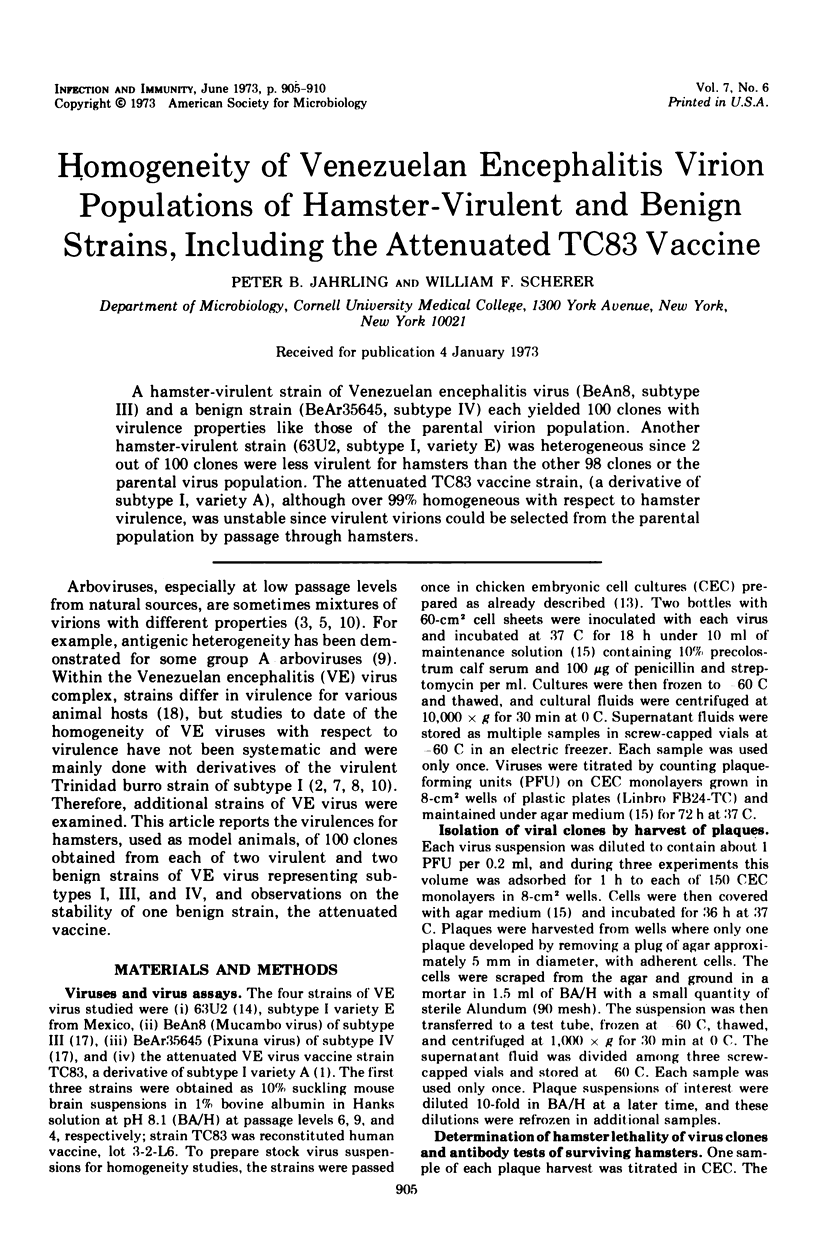
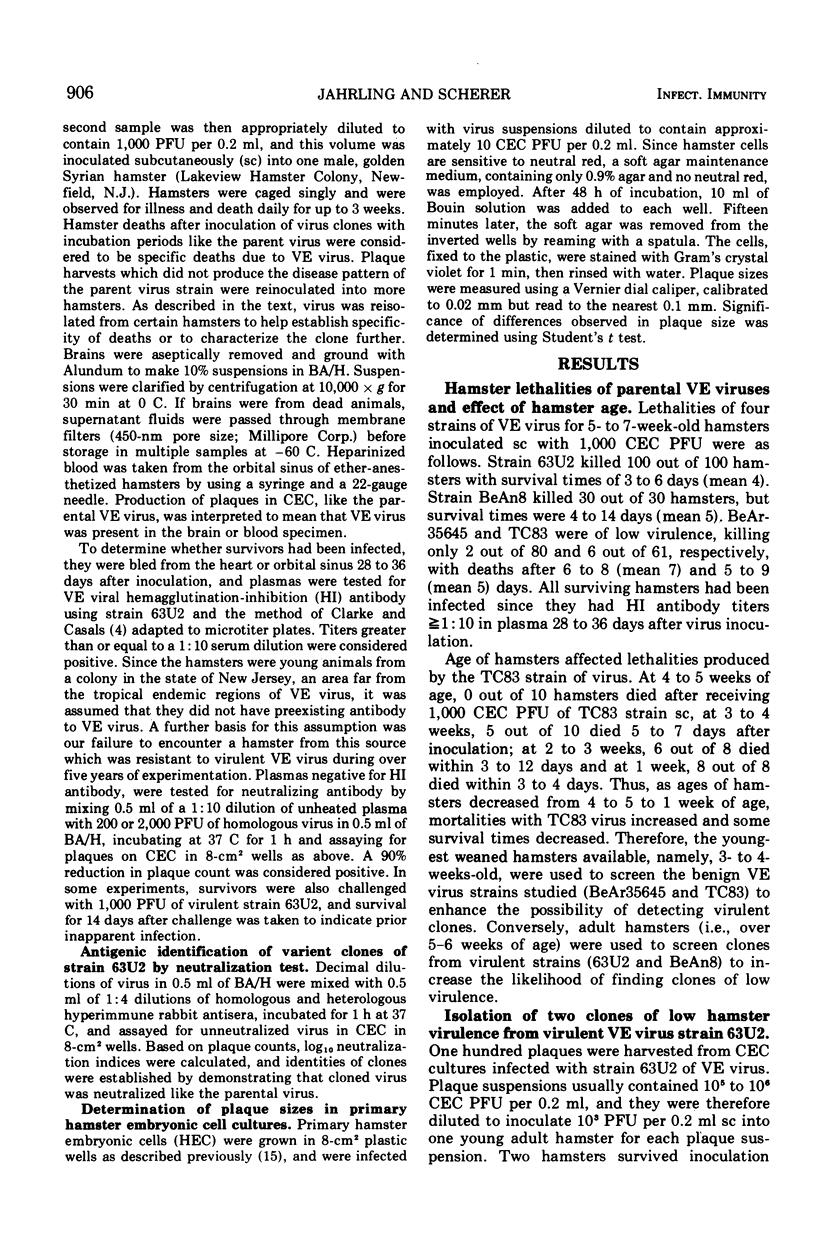
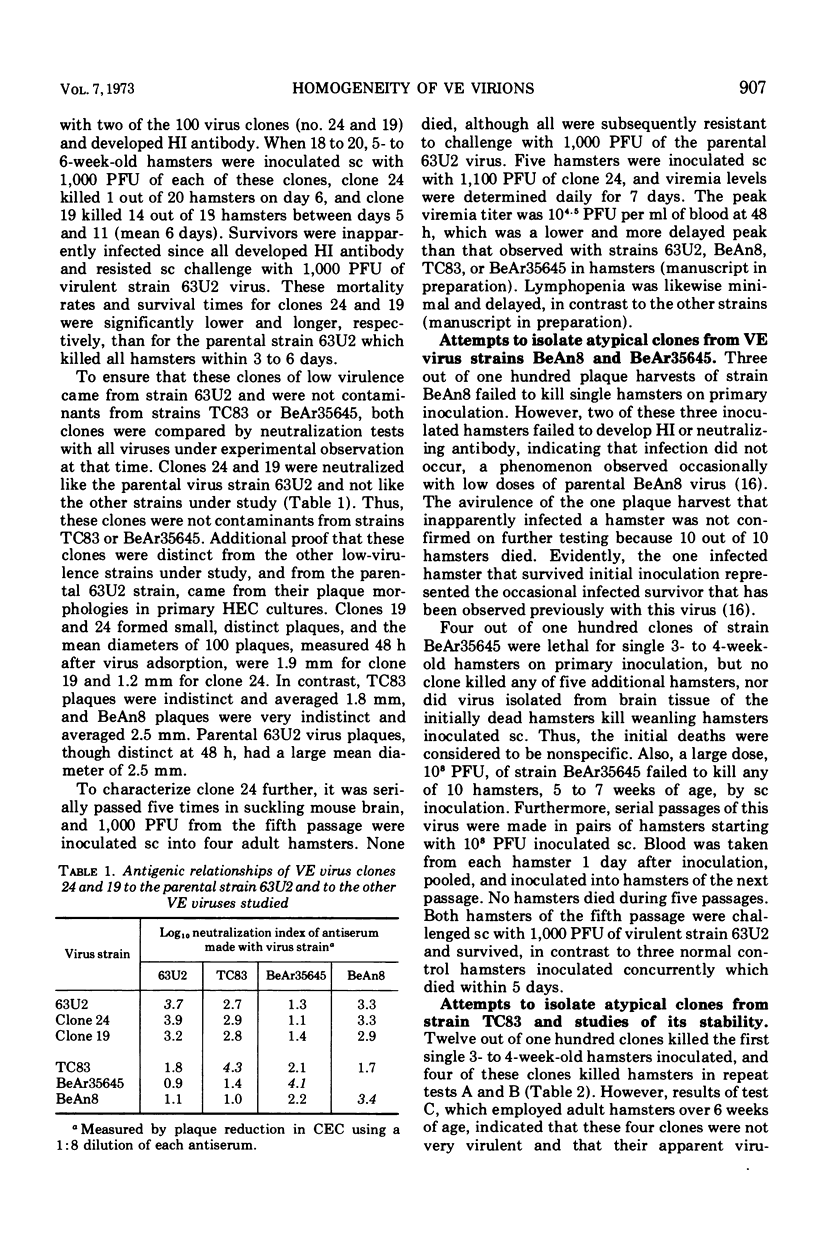
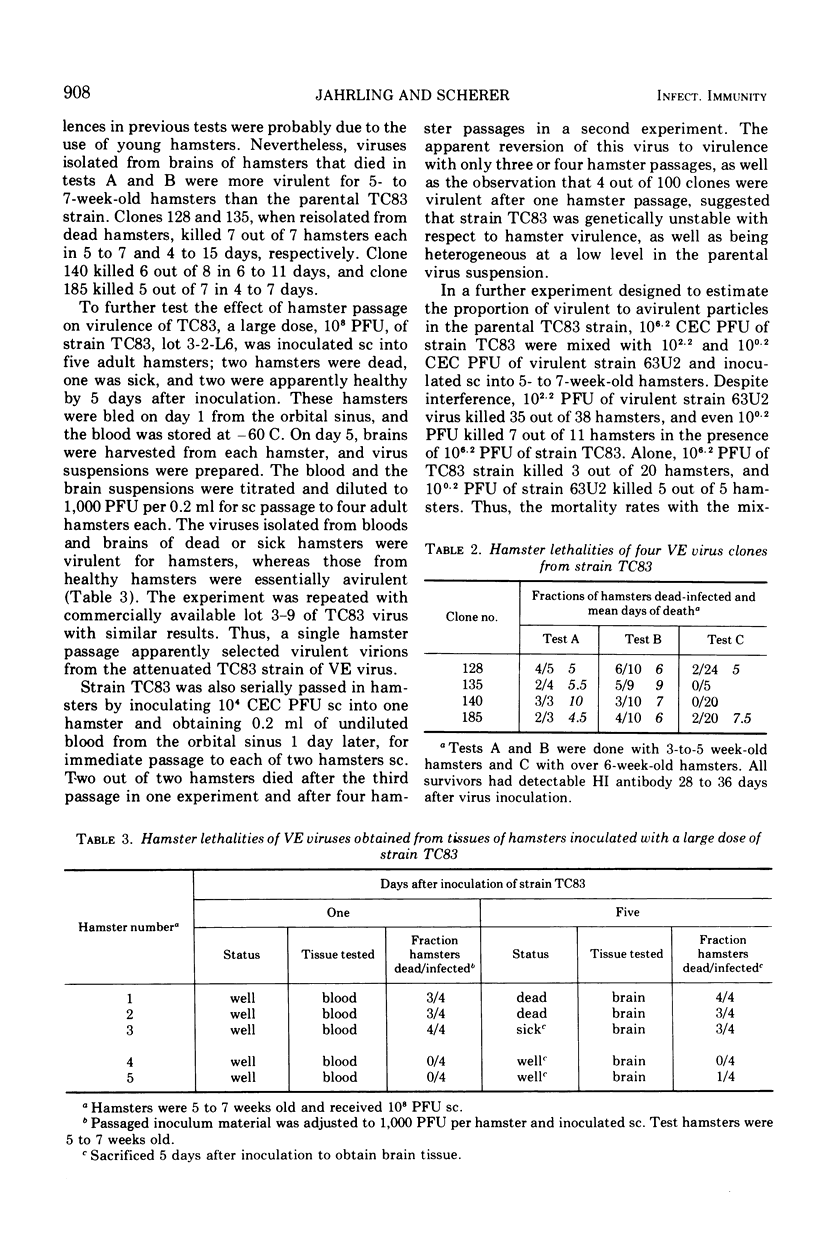
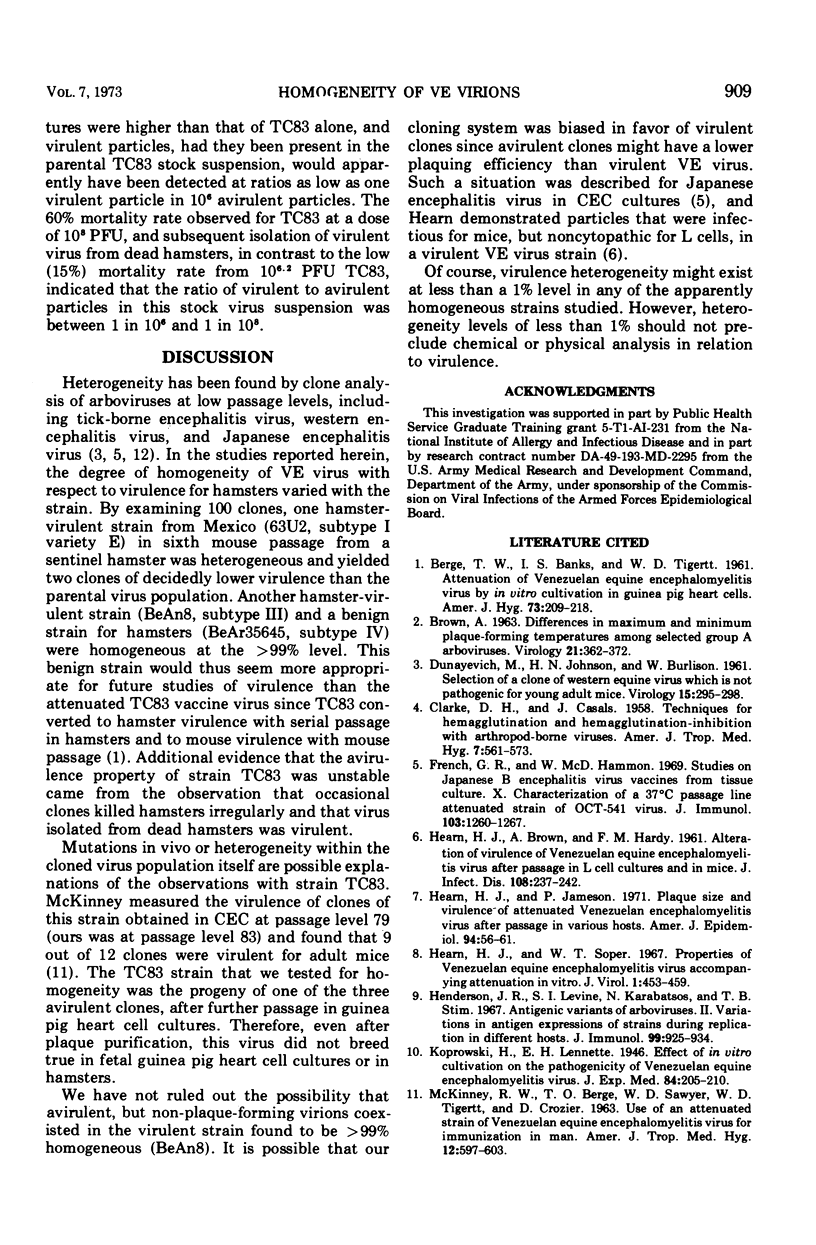
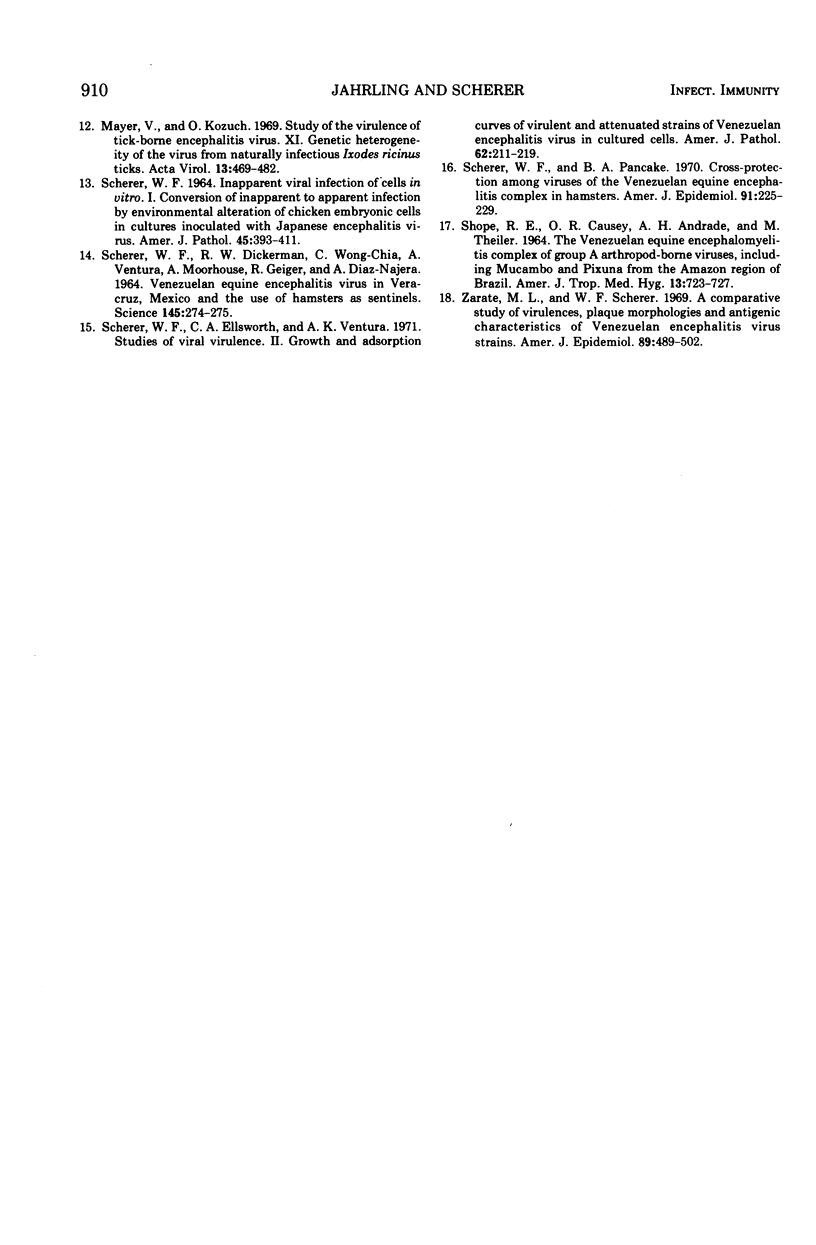
Selected References
These references are in PubMed. This may not be the complete list of references from this article.
- BROWN A. DIFFERENCES IN MAXIMUM AND MINIMUM PLAQUE-FORMING TEMPERATURES AMONG SELECTED GROUP A ARBORVIRUSES. Virology. 1963 Nov;21:362–372. doi: 10.1016/0042-6822(63)90197-1. [DOI] [PubMed] [Google Scholar]
- CLARKE D. H., CASALS J. Techniques for hemagglutination and hemagglutination-inhibition with arthropod-borne viruses. Am J Trop Med Hyg. 1958 Sep;7(5):561–573. doi: 10.4269/ajtmh.1958.7.561. [DOI] [PubMed] [Google Scholar]
- DUNAYEVICH M., JOHNSON H. N., BURLESON W. Selection of a clone of western equine virus which is not pathogenic for young adult mice. Virology. 1961 Nov;15:295–298. doi: 10.1016/0042-6822(61)90361-0. [DOI] [PubMed] [Google Scholar]
- French G. R., Hammon W. M. Studies on Japanese B encephalitis virus vaccines from tissue culture. X. Characterization of a 37 degreeC passage line attenuated strain of OCT-541 virus. J Immunol. 1969 Dec;103(6):1260–1267. [PubMed] [Google Scholar]
- HEARN H. J., Jr, BROWN A., HARDY F. M. Alteration of virulence of Venezuelan equine encephalomyelitis virus after passage in L cell cultures and in mice. J Infect Dis. 1961 Mar-Apr;108:237–242. doi: 10.1093/infdis/108.2.237. [DOI] [PubMed] [Google Scholar]
- Hearn H. J., Jameson P. Plaque size and virulence of attenuated Venezuelan equine encephalomyelitis virus after passage in various hosts. Am J Epidemiol. 1971 Jul;94(1):56–61. doi: 10.1093/oxfordjournals.aje.a121295. [DOI] [PubMed] [Google Scholar]
- Hearn H. J., Jr, Soper W. T. Properties of Venezuelan equine encephalomyelitis virus accompanying attenuation in vitro. J Virol. 1967 Jun;1(3):453–459. doi: 10.1128/jvi.1.3.453-459.1967. [DOI] [PMC free article] [PubMed] [Google Scholar]
- Henderson J. R., Levine S. I., Karabatsos N., Stim T. B. Antigenic variants of arboviruses. II. Variations in antigen expressions of strains during replication in different hosts. J Immunol. 1967 Nov;99(5):925–934. [PubMed] [Google Scholar]
- MCKINNEY R. W., BERGE T. O., SAWYER W. D., TIGERTT W. D., CROZIER D. USE OF AN ATTENUATED STRAIN OF VENEZUELAN EQUINE ENCEPHALOMYELITIS VIRUS FOR IMMUNIZATION IN MAN. Am J Trop Med Hyg. 1963 Jul;12:597–603. doi: 10.4269/ajtmh.1963.12.597. [DOI] [PubMed] [Google Scholar]
- Mayer V., Kozuch O. Study of the virulence of tick-borne encephalitis virus. XI. Genetic heterogeneity of the virus from naturally infectious Ixodes ricinus ticks. Acta Virol. 1969 Nov;13(6):469–482. [PubMed] [Google Scholar]
- SCHERER W. F., DICKERMAN R. W., CHIA C. W., VENTURA A., MOORHOUSE A., GEIGER R. VENEZUELAN EQUINE ENCEPHALITIS VIRUS IN VERACRUZ, MEXICO, AND THE USE OF HAMSTERS AS SENTINELS. Science. 1964 Jul 17;145(3629):274–275. doi: 10.1126/science.145.3629.274. [DOI] [PubMed] [Google Scholar]
- SCHERER W. F. INAPPARENT VIRAL INFECTION OF CELLS IN VITRO. I. CONVERSION OF INAPPARENT TO APPARENT INFECTION BY ENVIRONMENTAL ALTERATION OF CHICKEN EMBRYONIC CELLS IN CULTURES INOCULATED WITH JAPANESE ENCEPHALITIS VIRUS. Am J Pathol. 1964 Sep;45:393–411. [PMC free article] [PubMed] [Google Scholar]
- SHOPE R. E., CAUSEY O. R., DE ANDRADE A. H. THE VENEZUELAN EQUINE ENCEPHALOMYELITIS COMPLEX OF GROUP A ARTHROPOD-BORNE VIRUSES, INCLUDING MUCAMBO AND PIXUNA FROM THE AMAZON REGION OF BRAZIL. Am J Trop Med Hyg. 1964 Sep;13:723–727. doi: 10.4269/ajtmh.1964.13.723. [DOI] [PubMed] [Google Scholar]
- Scherer W. F., Ellsworth C. A., Ventura A. K. Studies of viral virulence. II. Growth and adsorption curves of virulent and attenuated strains of Venezuelan encephalitis virus in cultured cells. Am J Pathol. 1971 Feb;62(2):211–219. [PMC free article] [PubMed] [Google Scholar]
- Scherer W. F., Pancake B. A. Cross-protection among viruses of the Venezuelan equine encephalitis complex in hamsters. Am J Epidemiol. 1970 Feb;91(2):225–229. doi: 10.1093/oxfordjournals.aje.a121131. [DOI] [PubMed] [Google Scholar]
- Zarate M. L., Scherer W. F. A comparative study of virulences, plaque morphologies and antigenic characteristics of Venezuelan encephalitis virus strains. Am J Epidemiol. 1969 Apr;89(4):489–502. doi: 10.1093/oxfordjournals.aje.a120961. [DOI] [PubMed] [Google Scholar]


